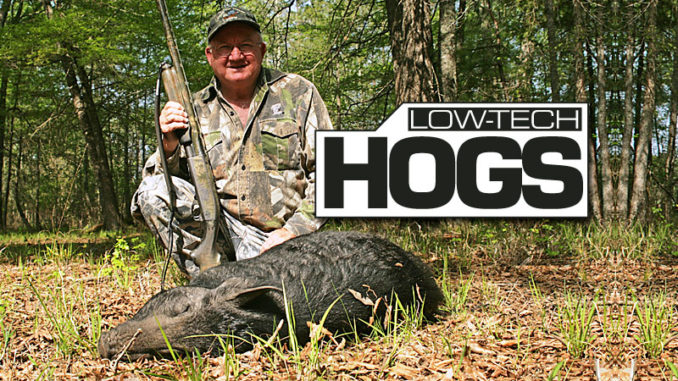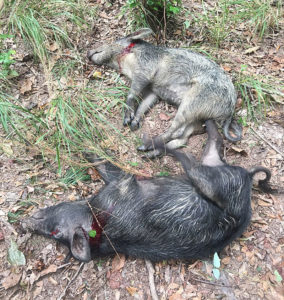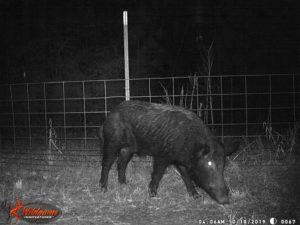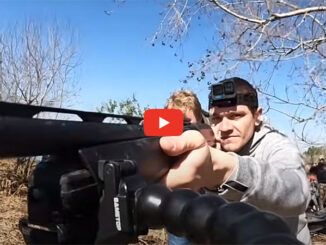
Dispense with the night-vision optics, suppressors and fancy weapons. Louisiana hunters can work on the feral hog population with a minimum investment of time and effort.
Loud, crunching noises announced the presence of something other than squirrels busily cutting acorns in the oaks along a dry creek bed one early October morning.
Looking up the creek, I saw the source of the crunching: several hogs feeding on hickory nuts. They were a little too far to shoot with a .22 and were moving away. I refocused on the squirrels and continued hunting.
The creek took a bend toward a pine sapling plantation, an ideal bedding area, and later in the morning, here were the hogs again, this time approaching, about to wrap up the morning feeding session and enter the thick cover for a nap. A sow was moving toward me at a steady walk, closing the distance to no more than a few steps. A .22 bullet just behind the ear dropped her without as much as a squeal. Another hog stopped to look at the fallen sow. The crosshairs were centered between its eyes when the trigger broke. A red boar trotted into the open and stopped, searching for the source of the noise. Another .22 bullet behind another ear, and you know the rest. The remaining members of the sounder knew things were not going well and ran hard for the thicket.

My son and I enjoy hunting squirrels with .22 rifles, and we do not hesitate to pick off a hog at every opportunity. In early October, we accounted for 11 hogs in addition to all the squirrels we cared to harvest. Considering the amount of rooting, tracks and sightings of large sounders in our territory, eliminating 11 probably had minimal impact. But any effort to control the rapid and alarming increase in feral hog numbers helps.
The numbers add up
Anyone wishing to spend thousands of dollars on hog-eradication gear will have no problem doing so. Night-vision and thermal-imaging sights, suppressors, hog rifles and hog calibers abound. Hog attractants and even hog calls are sold. For anyone interested in trapping, there are traps equipped with cameras and cell-phone capability, allowing the user to view live images in the trap and shut the gate at will. Feral hog control remains a “next big thing” in the outdoor industry. Hunting hogs with dogs remains popular and effective, but expensive. You may trust me on that one.
While expensive, high-tech gear may make things easier, a hog felled by a .22 or .30-30 is just as dead. We often miss opportunities to eliminate hogs while bowhunting and small-game hunting, or simply going about chores involved in getting ready for hunting season. Since I am in the woods for one reason or another throughout the year, I keep a rifle in the truck in case I see hogs; I do, frequently. Glassing openings such as power lines and clear cuts may reveal feeding hogs. A quick stalk can result in success.
Deer concerns
Deer hunters are often reluctant to shoot hogs, fearing it may ruin their chances at a buck. That’s understandable, but consider the fact that if hogs are in the area, deer probably aren’t. Consider also that many times we can dispatch a hog or two without disturbing deer.
I know that seems unlikely, but it does happen. On a morning hunt, a boar walked into the food plot at dawn. I shot before he could do any more damage to my already rooted-up planting. Not long after, a young buck showed up and noticed the dead boar. He was a little nervous and cautiously circled but then settled down and went about his business. Later, a doe and two more bucks showed up, completely ignoring the rooter.

On an afternoon hunt, a nice 8-pointer showed up and began feeding. He was suddenly alert to something in the woods and took off. The sounder he had seen or heard came into view. At the shot, all but one hurried off. Incredibly, minutes later, the buck was back. I left him at dark still feeding peacefully and returned the next morning to remove the hog carcass.
Our hunting lease has had significant damage, and so have the lawns and roadsides in adjacent residential area. Drive the roads after dark and you are sure to see hogs inflicting more damage. They are also quickly consuming every acorn that hits the ground, leaving little fall mast to sustain deer and other wildlife through the winter.
Dealing with feral hogs does not have to be an expensive proposition with a big investment in new or high tech gear. Effective, basic hunting techniques and persistence combined with a favorite deer or varmint rifle can go a long way towards controlling the problem and supporting deer, turkeys and other desirable wildlife species.
